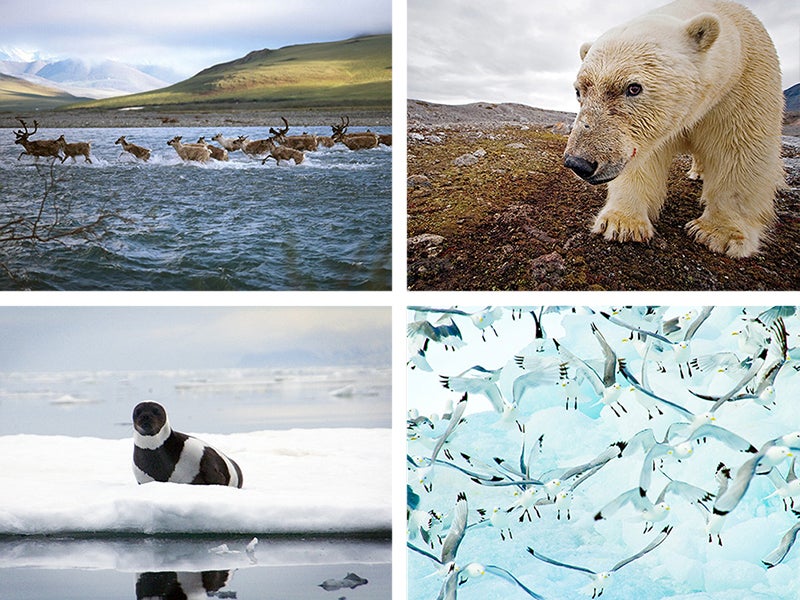Earthjustice goes to court for our planet.
We’re here because the earth needs a good lawyer.
Trump Administration’s Final Push to Drill the Arctic Refuge: What Comes Next?
This page was published 3 years ago. Find the latest on Earthjustice’s work.
In its waning days of power, the Trump administration is attempting to open the Arctic for oil and gas drilling in sacred and irreplaceable Alaskan wilderness. This month, the administration issued a “call for nominations,” inviting oil and gas companies to choose where in the Arctic National Wildlife Refuge they want to drill for oil. This move should be seen for what it is: a last-second, shoddily planned effort to wring private profits out of our nation’s public lands.
The administration is rushing ahead a lease sale that prioritizes oil and gas development over all else in the coastal plain, including local Indigenous communities, rare wildlife, and the intensifying threat of climate change. While these actions are concerning, we have time, legal tools, and years of courtroom success to defend the Arctic Refuge from this attack.
Why is drilling in the Arctic Refuge an uphill battle for the Trump administration?
- The kickoff sets up a timeframe in which the Trump administration could hold a lease sale — where it would receive bids on lease parcels — but might run out of time before it could issue the leases. Processing bids typically takes several weeks.
- If the administration holds a lease sale, but doesn’t get as far as issuing leases, the Biden administration can avoid issuing them if it concludes the drilling program or lease sale were unlawfully adopted.
- Even if leases are issued, the Biden administration can withdraw them if it concludes they were issued unlawfully or pose too great a threat to the environment.
- Once leases are issued, fossil-fuel companies must apply for additional permits before they can start drilling. Those permits would be subject to legal challenge.
- Earthjustice is already challenging the drilling program in court, and we are prepared to challenge the Trump administration at every step they take to implement the program.
Watch our virtual post-election town hall to learn more.
Is there already oil and gas drilling in the Arctic Refuge?
-
No. The Arctic Refuge, which spans 19 million acres across northeast Alaska, is one of the planet’s last fully intact wild landscapes.
What are the dangers of drilling in the Arctic Refuge?
- The Arctic is ground zero for climate change, with temperatures rising more than twice as fast as anywhere else on Earth.
- Scientists believe that if we’re to avoid the most catastrophic impacts of climate change, it is essential to keep Arctic fossil fuel reserves in the ground.
- Any oil produced in the region wouldn’t come to market for a decade or more, given the remoteness and need for massive and costly infrastructure. By then we need to be well shifted from fossil fuels, not locking in more for decades to come.
- Drilling in the Arctic Refuge would disrupt and pollute the habitat of many rare birds, fish, and mammals, including polar bears and caribou.
- This destruction would threaten the food security and cultural identity of Indigenous communities who have stewarded these lands since time immemorial.
What has Earthjustice been doing to defend the Arctic Refuge?
- In April 2018, when Trump administration released its notice of intent to explore oil and gas drilling in the Arctic Refuge, Earthjustice and other prominent environmental organizations came together in a coalition along with local Indigenous people. Today, there are four separate lawsuits challenging the initial adoption of the program.
- Earthjustice is currently representing Audubon, Center for Biological Diversity, Friends of the Earth, and NRDC (which also serves as co-counsel) in a legal challenge over the legitimacy of the drilling program because of the administration’s failures to comply with the National Environmental Policy Act, Endangered Species Act, and Refuge Administration Act.
We have spent decades working in partnership with tribal communities and conservation groups to defend the Arctic from fossil fuel development. Today, the movement in defense of the Arctic Refuge, which includes an overwhelming majority of voters, is larger and stronger than ever.
Here’s how you can join us:
- Read our digital feature, Northern Fights, for a deep dive into our latest efforts to protect the Arctic.
- Write the Bureau of Land Management and tell them to defend the Arctic Refuge from reckless oil drilling.

